The Microsoft Surface Laptop 3 Showdown: AMD's Ryzen Picasso vs. Intel's Ice Lake
by Brett Howse & Andrei Frumusanu on December 13, 2019 8:30 AM ESTSystem Performance
Moving on from SPEC to some of our more traditional laptop tests, I’ve taken the opportunity to add some new tests to the suite, which we’ll include on all laptops going forward. While SPEC is a fantastic set of tests to probe the limits of a platform, not everyone is going to run a workload that runs at nearly 100% CPU utilization for such a long time on a laptop. The 8-Thread tests took 4.5 hours to complete on Ice Lake, and 6.5 hours to complete on Picasso, which is likely not something most people would turn to a thin and light laptop for, so it’s important to see how both platforms perform on shorter tests where they can leverage their peak boost frequencies for a higher percentage of the duration.
PCMark 10
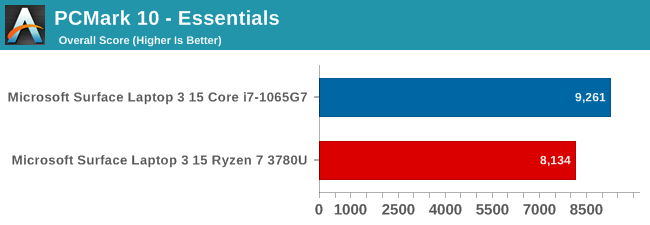

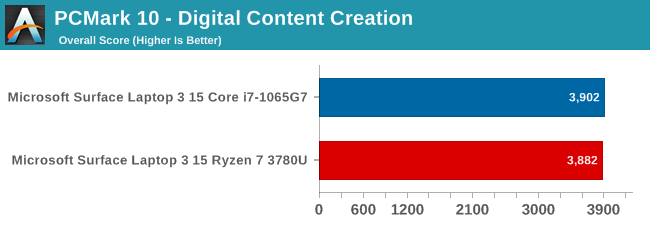
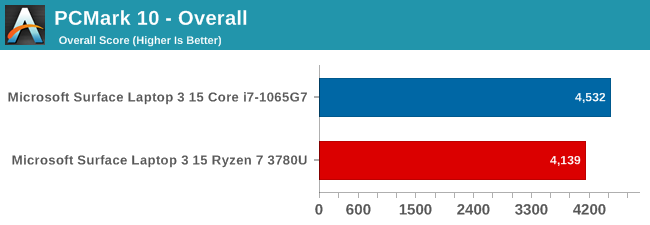
PCMark 10 consists of several real-world tests, including web, video conferencing, spreadsheets, writing, and more. There are several GPU tests as well, including rendering, and some gaming. The suite also measures application start-up, and all aspects of the system’s performance factor into the score.
Intel’s CPU performance lead shows clearly here again, with significant leads in both the Essentials and Productivity tests, although AMD’s strong GPU pulls the Ryzen system very close on the Digital Content Creation tasks. But that is not enough to turn the tide, and the Ice Lake platform carries this win.
Cinebench R20
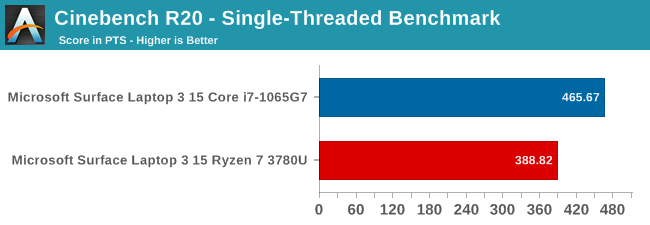
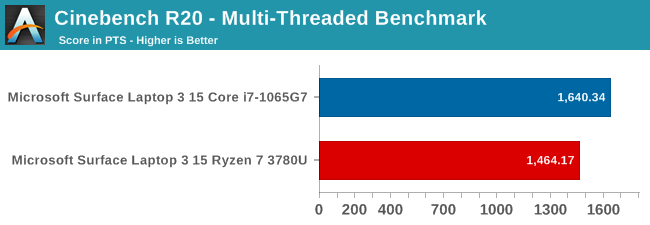
Looking at the latest version of Cinebench tells a similar story as to what we’ve seen so far. Ice Lake’s significant IPC lead pulls it way ahead. On the multi-threaded test, the AMD platform does close the gap somewhat, which is similar to the SPEC rate 8 results.
7-Zip
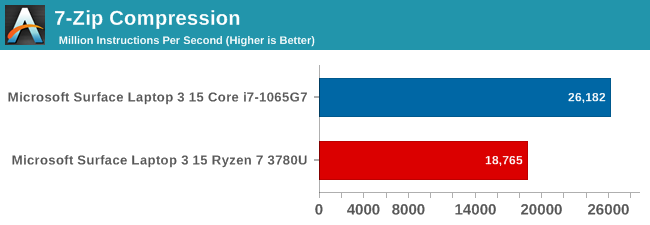
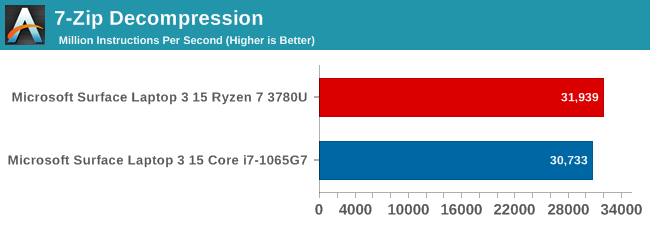
Checking out the popular 7-Zip file compression tool, the results are in-line with what we see in the desktop space. Intel generally has a lead on the compression side, but AMD claws back at decompression. It is a rare win on the CPU side for AMD here.
Handbrake
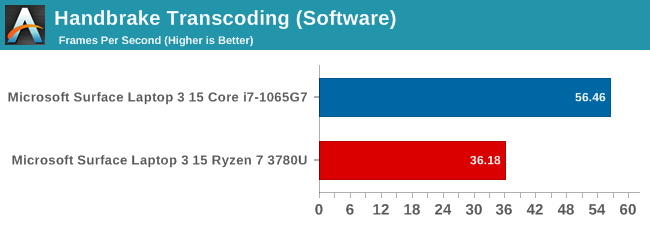
Transcoding is a popular task, and Handbrake is one of the most popular tools. For this test, a 1080p movie is converted to 720p using the x264 encoder. Once again, Ice Lake offers significantly more performance when transcoding in software.

Handbrake also supports various hardware encoders, such as Intel’s QuickSync, which provides significantly quicker transcodes at the same settings – albeit at larger file sizes and slightly lower quality compared to the software transcode, according to the Handbrake documentation. QuickSync has been very popular, and has been around quite a while. AMD also offers hardware encoding and decoding with their Video Core Next platform. Handbrake does support AMD’s Video Coding Engine (VCE) but the Surface Laptop 3 does not offer this as an option in Handbrake, so it was not able to be tested. As this is the only current Ryzen mobile APU we’ve tested, it may be a driver issue specific to the Surface branded processor.
x264
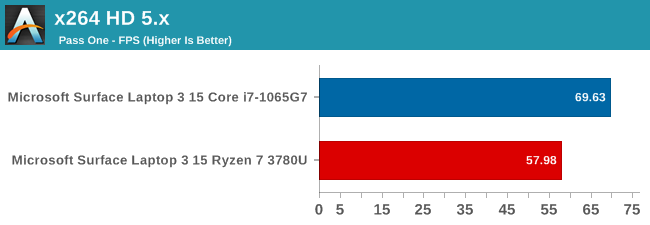
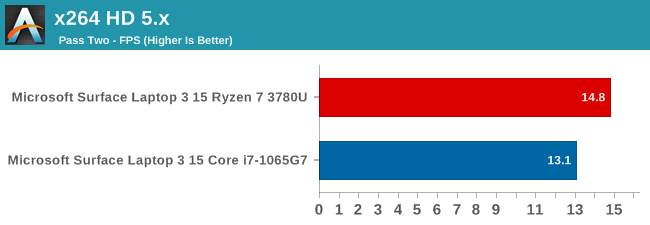
Our previous transcoding test, x264, was also run. Here we see that once again Ice Lake has a significant performance advantage, as it did with Handbrake software encoding.
Web Tests
All of our web tests were run with the current version of Microsoft Edge in Windows 10 1909. Web results are highly impacted by the underlying scripting engine, and Microsoft is going to be moving Edge from the EdgeHTML rendering engine to the Chromium open-source project that powers Google Chrome. When they make this change, expected early in 2020, we’ll revamp our suite with new tests.
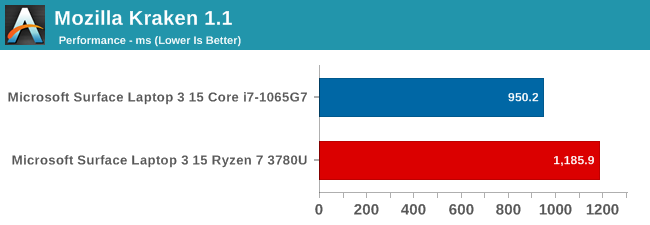

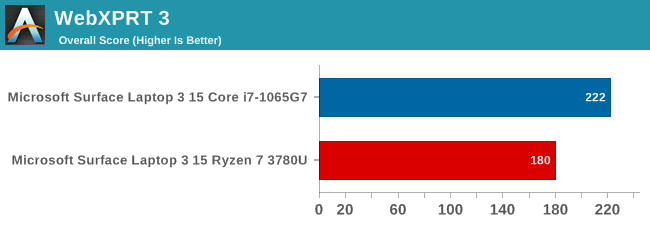
Intel has aggressively pushed their frequency ramping with Speed Shift, and one of the biggest beneficiaries of Speed Shift is web scripting, since the tasks tend to be very short. AMD is addressing this in Zen 2 with Collaborative Power Performance Control 2, or CPPC2, which is not as elegant of a name as Speed Shift, but promises to drop Zen’s frequency ramping from ~30 ms to ~1 to 2 ms, and will be a welcome addition on our web tests.










174 Comments
View All Comments
MBarton - Monday, December 30, 2019 - link
Agreed. Even the outlook for 2020 server ICL has vanished from Intel's presentations. If they can't get working server parts out, there definitely won't be a 10nm desktop part in 2020.deil - Monday, December 16, 2019 - link
I just wonder why...16 GB Dual-Channel DDR4-2400 16 GB Dual-Channel LPDDR4X-3733
AMD gains A LOT from faster ram, what they get? cheappest....
Brett Howse - Monday, December 16, 2019 - link
That's all that Picasso supportseastcoast_pete - Wednesday, December 18, 2019 - link
That is why I am more upset with AMD not putting their best foot forward on mobile. A mobile APU based on Zen2 in 7 nm with Navi-based graphics and an LPDDR4 or LPDDR5 capable memory controller would have given Intel's Ice Lake a real challenge. Instead, AMD is a full generation behind. Ironic, as it's the other way around for desktops.MBarton - Monday, December 30, 2019 - link
Why would a cash-strapped AMD "put their best foot forward" in the mobile segment. It's the lowest profit market of the three. They need profit margins and server/HEDT are FAR more profitable than mobile.MutualCore - Monday, December 16, 2019 - link
Why nothing about SSD performance? This is a critical point for people that need to copy large amounts of data.derstef - Wednesday, December 18, 2019 - link
"DDR4-2400" vs "LPDDR4X-3733" ... fair comparision on the GPU side of things? I dont think so.Butterfish - Friday, December 20, 2019 - link
Your argument is irrelevant. Both are using the best possible RAM they supported. It is AMD’s fault to recycle old chip with outdated spec. We are comparing mobile platform (laptop), not desktop. Everything is highly integrated with CPU influences GPU performance. As both laptops are house in the same cooling solution it is a fair comparison to see which platform is faster in various task.maroon1 - Sunday, January 12, 2020 - link
AMD does not support LPDDR4XAnsley11 - Wednesday, December 18, 2019 - link
$2000, you've got to be kidding me! Why would anyone waste there money on these? I can get a $1000 desktop then can blow these away, and get a couple hundred dollar tablet to do the tablet stuff. Heck, I could probably get both for under $1000 if I shop around and am smart with my choices. People waste FAR too much money on unnecessary tech.